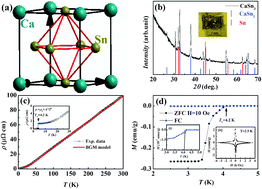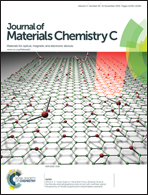Superconductivity in CaSn3 single crystals with a AuCu3-type structure†
Abstract
We report the superconductivity of CaSn3 single crystals with a AuCu3-type structure, namely cubic space group Pm![[3 with combining macron]](https://www.rsc.org/images/entities/char_0033_0304.gif) m. The superconducting transition temperature TC = 4.2 K is determined by the magnetic susceptibility, electrical resistivity, and heat capacity measurements. The magnetization versus magnetic field (M–H) curve at low temperatures shows a typical-II superconducting behavior. The estimated lower and upper critical fields are about 125 Oe and 1.79 T, respectively. The penetration depth λ(0) and coherence length ξ(0) are calculated to be approximately 1147 nm and 136 nm by the Ginzburg–Landau equations. The estimated Sommerfeld coefficient of the normal state γN is about 2.9 mJ mol−1 K−2. ΔC/γNTC = 1.13 and λep = 0.65 suggest that the CaSn3 single crystal is a weakly coupled superconductor. Electronic band structure calculations show a complex multi-sheet Fermi surface formed by three bands and a low density of states (DOSs) at the Fermi level, which is consistent with the experimental results. Based on the analysis of electron–phonon coupling of AX3 compounds (A = Ca, La, and Y; X = Sn and Pb), we theoretically proposed a way to increase TC in the system.
m. The superconducting transition temperature TC = 4.2 K is determined by the magnetic susceptibility, electrical resistivity, and heat capacity measurements. The magnetization versus magnetic field (M–H) curve at low temperatures shows a typical-II superconducting behavior. The estimated lower and upper critical fields are about 125 Oe and 1.79 T, respectively. The penetration depth λ(0) and coherence length ξ(0) are calculated to be approximately 1147 nm and 136 nm by the Ginzburg–Landau equations. The estimated Sommerfeld coefficient of the normal state γN is about 2.9 mJ mol−1 K−2. ΔC/γNTC = 1.13 and λep = 0.65 suggest that the CaSn3 single crystal is a weakly coupled superconductor. Electronic band structure calculations show a complex multi-sheet Fermi surface formed by three bands and a low density of states (DOSs) at the Fermi level, which is consistent with the experimental results. Based on the analysis of electron–phonon coupling of AX3 compounds (A = Ca, La, and Y; X = Sn and Pb), we theoretically proposed a way to increase TC in the system.


 Please wait while we load your content...
Please wait while we load your content...